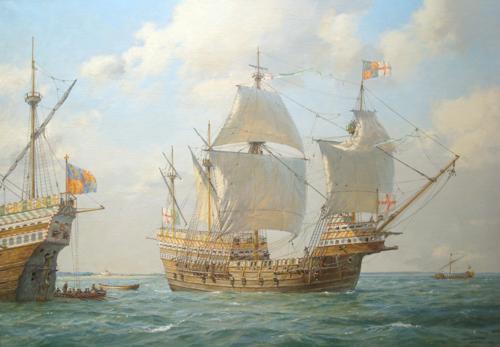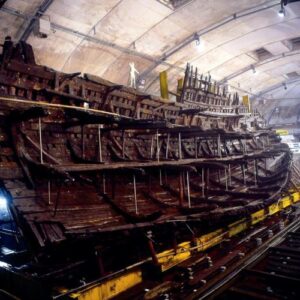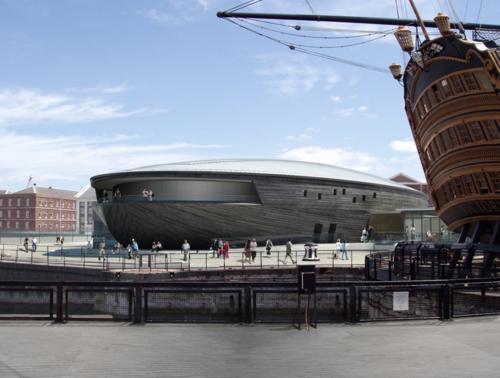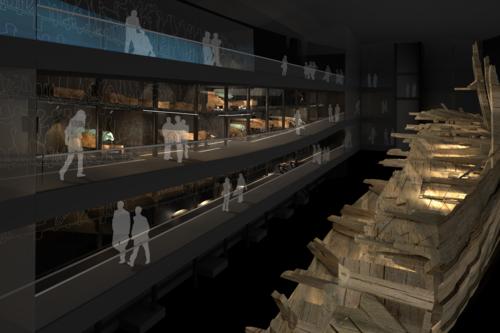The Mary Rose

The Mary Rose was a famous Tudor warship built in Portsmouth for Henry VIII’s navy between 1509 and 1511. Henry VIII ordered the building of the Mary Rose, thought to be named after his sister Mary and the Tudor Rose, and the Peter Pomegranate to reinforce his navy and to protect England from the threats of the French Navy and Scottish fleets.

Both the Mary Rose and the Peter Pomegranate were very different to ships built during Henry VII’s reign because they were carvel, rather than clinker, built and were equipped with heavy guns which were mounted near the waterline. The Mary Rose was equipped with 78 guns originally and upgraded to 91 in 1536 and her carvel hull allowed watertight gun-ports to be constructed. Her ability to fire broadside made her both the pride of the English Navy and Henry VIII’s favourite ship. Unfortunately, after over 30 years of service in the navy, the Mary Rose sank accidentally in the Solent on 19th July 1545 during an engagement with the French fleet.
Although she sank in 1545, the good news is that she was raised in 1982 and divers were able to recover around 19,000 remarkably preserved Tudor artefacts which can teach so much about Tudor life and times.
The Mary Rose’s Career
The most many people know about the Mary Rose is that she was a Tudor warship that accidentally sank, but she was far more than that and actually had a very illustrious career before her tragic end in 1545. The ship’s career included:-
- Being the flagship of the English Navy against France in 1512 – Under the admiralty of Sir Edward Howard, she was used against the French just off Brittany.
- Under the admiralty of Sir Thomas Howard, the Mary Rose was used in 1513 to transport Howard and his troops to Newcastle to help in the war against Scotland.
- War with France 1522-1525 – According to her Vice Admiral Fitzwilliam, she outsailed all of the ships in her fleet.
- A major refit in 1528 – Click here to see a list of materials used to repair and refit the Mary Rose.
- 1536-1538 – Rebuilding and re-arming.
- 1544-1545 – English fleet escorting reinforcements to Boulogne and then moving into the Solent to intercept any French ships.
The Sinking of the Mary Rose
The Mary Rose served in Henry VIII’s navy for over 30 years and had a very impressive career so why on earth did she sink. There are various theories about this:-
- She was sunk by a French hit – According to the French fleet, they hit her and she sank after they lured the English ships within range of their main fleet.
- She heeled over in the wind and water entered her gun ports – Van der Delft, the Imperial ambassador, told of how she sank, drowning just under 500 men, and how he “was told by a Fleming among the survivors that when she heeled over with the wind the water entered by the lowest row of gun ports which had been left open after firing.”
- Error – According to Sir Peter Carew, brother of the Vice Admiral of the Mary Rose, Sir George Carew who died when the ship sank, his uncle Sir Gawain Carew had sailed past the Mary Rose as she began to heel and asked Sir George what was wrong. Sir George replied that “he had the sort of knaves whom he could not rule.”
Although Burchet and Sir Walter Raleigh both attributed the loss of the Mary Rose to her gunports being too close to the water line, the height of 16 inches that Burchet gives is definitely wrong as she would never have been able to even leave port if this was the case because her scuppers would have been submerged. The archaeological evidence points to the the gunports having four feet of clearance.
The Mary Rose Trust’s website says that the most likely cause is handling error, as Carew reported, caused by a lack of discipline and confusion in the heat of battle. Excavation of the ship has also revealed that the ship’s ballast had shifted to the starboard side, but it is not known whether this happened as a result of the ship sinking or whether it was the cause. The Mary Rose trust say “Once the angle of heel was sufficient for water to enter the gunports the fate of the ship was sealed.”
The Raising of the Mary Rose
Attempts to raise the Mary Rose in the summer of 1545 were unsuccessful and she lay in her watery grave until she was rediscovered nearly 300 years later on 16th June 1836 when a fisherman snagged his gear on the wreck. A diver, John Deane, was diving on a nearby wreck and agreed to help the fisherman disentangle his gear in return for a half share of whatever the gear was caught up on. Dean found the Mary Rose and between 1836 and 1840 was able to recover a number of items including iron guns, bows and timbers.

In 1965, Alexander McKee decided to try and find the wreck of the Mary Rose and with the collaboration of Professor Harold E Edgerton and John Mills, and their sonar systems, a sub-seabed anomaly was found in 1967 which was confirmed in 1968 by a sonar survey. Between 1968 and 1971, dives were carried out on the area and timbers and even an iron gun were recovered. On 5th May 1971, Percy Ackland discovere three of the port frames of the Mary Rose. The Mary Rose had been found.
The Mary Rose Trust was formed in 1979 and an archaeological team led by Dr Margaret Rule CBE began to excavate the Mary Rose wreck. This culminated in the raising of the Mary Rose on 11th October 1982 by a team of Royal Engineers. The wreck was placed in a dry dock with a relative humidity of 95% and a temperature of 2-6ºC. A preservation programme then began in earnest.
Artefacts and Findings
During the excavation and raising of the Mary Rose, many items were found, including:-
- Skeletons – The remains of around half the crew.
- Medical equipment
- A Barber surgeon’s hat
- Navigational Equipment
- Weapons – guns, longbows and arrows
- Carpentry tools
- Utensils used for cooking and eating
- A musical instrument called a shawm
- Logs for the oven
- Playing dice and backgammon boards
- Lanterns
- Chests
- Combs
- Coins
Take a look at the slideshow to see some of these wonderfully preserved artefacts:-
[slideshow id= 143 w=400 h=300]

The Mary Rose 500 Appeal
Here at The Anne Boley Files, we have pledged to raise £500 to help build a new purpose built museum to house the ship and its artefacts. See our Mary Rose 500 Appeal Page for further details.
Here are some “virtual” photos of what the new museum will look like:-


Images from Wilkinson Eyre Architects
Make Your Own Mark on the Mary Rose Museum
We know from the artefacts that were found with the Mary Rose wreck that her crew engraved their personal possessions with their own individual marks and the Mary Rose Trust is going to incorporate some of these marks into the wooden panels which form the outer cladding of the new museum. Do you want to make your mark on this wonderful museum? You can by buying a plank:-
- £1,000 – A major plank etched with your full name
- £250 – A major plank etched with your initials
- £100 – A small plank etched with your initials
- £50 – A small unmarked panel
Plus, every person who buys a plank will be entered into a raffle to win a signed copy of the Limited Edition copy of the new painting of the Mary Rose which you can see at the top of this page. See the special “Make Your Mark” page at the Mary Rose 500 Appeal site for further details.
Has any one ever done a facial reconstruction on Anne ?
Hi Katie,
No, they haven’t done a facial construction on Anne because her body was buried in a mass grave along with other people who had been executed and although in Victorian times they believed that they had identified her and re-interred her under the altar in St Peter ad Vincula Chapel at the Tower of London, Alison Weir argues that this body could actually have been that of Catherine Howard. There is, therefore, no skull, for them to base a reconstruction on unless they dig up the floor of St Peter’s and try to figure out which head is Anne’s.
Thanks for the comment, Katie, I hope you have been enjoying browsing the site.
Not to be disrespectful like so many of you would see it as you don’t have a humorous bone in your body … But I guess you could say digging up the floor is one of those “shovel ready” projects? I’d say dig! You’ll never know what is there and what you’ll find. If it’s left untouched, you have a pretty floor hiding a wealth of treasure perhaps. The floor can be lifted carefully and replaced and there would be no change in the appearance.
Also, for me your site is just a place for travel in time. I love ships of all kinds. The Mary Rose is something I want to follow. Years ago, I was “crew” on the H.M.S. Bounty. No not the real one, but the replica that was build in the 1960’s for the 1962, motion picture Mutiny On The Bounty. For the longest time, it was docked in St. Petersburg, Florida and that is where I worked on the ship. On October 29th, 2012, Bounty was lost in the hurricane, “Sandy,” that went up the east coast of the U.S. The lost was blamed on her captain for sailing into the hurricane. After all, the Bounty was a movie prop, not a ship built for the high seas and the rough waters. She is in about 17,000 feet of water in the abyss.
Do you know how they think they’ve the body of Catherine Howard? If they were buried with only the cotton shifts they were executed in I fail to understand how they could come to that conclusion. Your site is extremely interesting! 🙂
Hi Julie,
I’ve written an article about the Victorian restoration of the chapel and the examinations of the bones by Dr Mouat – see https://www.theanneboleynfiles.com/anne-boleyn%e2%80%99s-body-found/6444/
The identifications were based on where they were found (they had records from the Tower which gave details on the burials), the age of the skeleton and the features.
I’m so glad you like the site! 🙂
divorced beheaded died divorce beheaded survived im henry the 8th i have 6 sorry wifes some might say i ruined there lives
Amazing!
Greetings from Carolina! I’m bored at work so I decided to
check out your site on my iphone during lunch break. I really like
the info you present here and can’t wait to take a look when I get home.
I’m surprised at how quick your blog loaded on my cell phone ..
I’m not even using WIFI, just 3G .. Anyhow, good site!
After I oriɡinally commenteed I sdem to havvе clickeɗ the -Notify me when
ոew commennts are added- checkbox and now whenever a comment is added I recieve 4 emails
with tɦе exact same comment. Тherе has to be an easу method you ccan remove
me from tɦat service? Appreciate it!
You should be able to cancel notifications from a link at the bottom of the emails you receive. Hope that helps!
I am curious why people are so quick to belittle Mary Boleyn. Why would some people be so sure this Mary Rose ship would be named for Mary Tudor when Henry 8th had a falling out with her after she married Charles Brandon and this enraged Henry 8th Her brother practically turned his back on her. It’s certainly possible this ship could be named after the Virgin Mary; but why are most people critical of the affairs Henry had with Mary Boleyn? According to one source, he did had a ship named for her; and no other mistress that Henry 8th took had such an honor. I think its a shame some people are so dismissive of her.
There was a ship in the ENglish Fleet named the Mary of Boloyn but it was referring to the port of Boulogne, not the name Boleyn. It’s listed in a list of captured French ships, as historian Lauren Mackay has pointed out, along with the Michael of Dieppe, Griffin of Dieppe, Mary of Hornflete (Hornfleur) and others. There’s nothing to link it with Mary Boleyn.